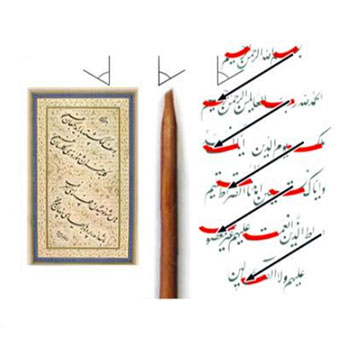The magnificence of the Islamic art has layed an immense impact on art forms across the world. Islamic art in turn has been influenced by its inseparable part; calligraphy. Islamic calligraphy finds its origin from Arabic script which is a modified form of the old Nabataean script, developed at the same time when Islam began expanding in the early 7th century. Arabic script, was then used to transcribe the Qur’an as the word of God and was therefore, with the religious association it was considered as the noblest of all art forms. Since then Islamic calligraphy has been practiced at almost all places where Islam has made its impact. For a long period it had also been consistently practiced as a major aesthetic expression in India especially; during the Mughal period. Farsi was the official language of the Mughal Emperor's court and Nasta’liq was used as the prominent style to write all the books, correspondences and Farman’s. Although, calligraphy enjoyed the status of the highest form of art in the Indian subcontinent, it has been abandoned in the modern era. This research indicates the need to emphasise on certain aspects of Persian calligraphy in the Mughal era that had been previously neglected. Calligraphy became increasingly decorative and ornate as a result of discouragement of representational or figural art by Islam. Calligraphy in such form enjoyed the centuries-long heyday. The territories of Persia and Hindustan provided fertile grounds for the growth of calligraphy styles. About 14 different styles of calligraphy developed around the world during the fourteenth century however, this research encompasses more than 35 distinct styles, including major and minor styles. This research is an effort to classify, explain, and identify them. These styles are different based on the region where they innovated, their functions, their characteristics and syntactic feature, their scope of use, activity period and the difficulty in reading and writing the script. The main task of the research is to demonstrate and identify the differences as well as similarities of the two schools of calligraphy in Persia and Hindustan respectively, during the Mughal period by focusing on its visual aspects. The method of research involves identifying the constituent elements in a semiotic system. In order to achieve the proper result, this research has depicted two steps. The first step is to collect information as the literature review and the second one is to analyse and compare the data. The study compares two schools of calligraphy in three different times of the Mughal period: in the beginning, middle and end of this period. The visual analysis attempts to present clearer results with the help of pictures, as the primary source and demonstrate exact results, by the use illustrations and their captions. A series of lines or angles have been used to prove the connection and difference between the two similar parts of two masterpieces in the same time era. Literature review is a very important part of the thesis report. The literature review as the first part of this thesis uses secondary sources such as old and new books and articles. Furthermore, in corroboration with the analyses, it has used primary sources and original data such as specimens of calligraphy in manuscripts and inscriptions. Identifying the difference of the Mughal calligraphy with the other schools is impossible except by a critico-historical study of all the aspects of this art. Therefore, the research studies the history of Islamic calligraphy in the entire world, including Islamic dynasties and Empires, A vast survey of available data about Islamic calligraphy which focuses on Persian calligraphy from various old and new sources in English, Farsi, Urdu and Arabic has been used. It also directly uses primary sources and the original data in corroboration with the analyses. Direct survey of the specimens of calligraphy, including available inscriptions in a variety of monuments’ inscriptions in Iran and India, as well as manuscripts of Islamic calligraphy in different museums, libraries and private collections in both the countries has been done.
